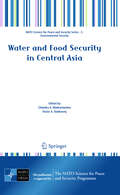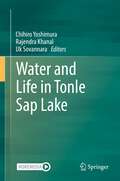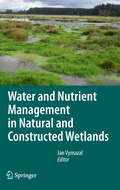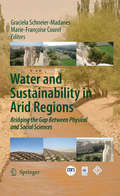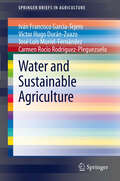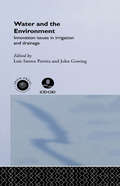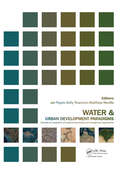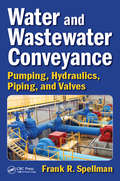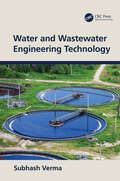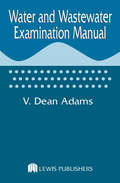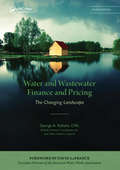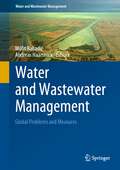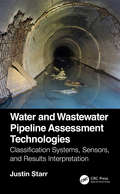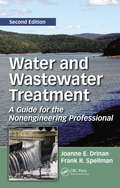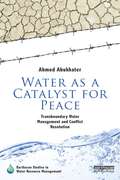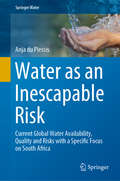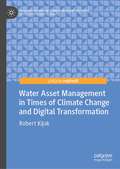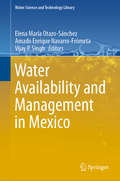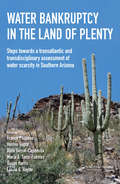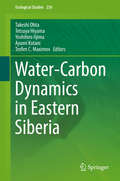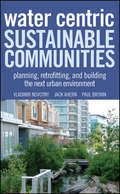- Table View
- List View
Water and Food Security in Central Asia
by Chandra Madramootoo Victor Dukhovny Robert S. Baker I. Helen FylesCentral Asia is vulnerable to water scarcity because it is located in semiarid and arid vegetation zones and large parts of its economy depend on water for irrigation and energy. Climate-change scenarios predict temperature increases and a rising number of extreme weather events, which will exacerbate water shortages in the future. In addition, the population of Central Asia is growing more rapidly than the rate of food production which is resulting in food insecurity in many parts of the region too. This volume reports the deliberations of politicians, scientists and representatives of water management organizations from throughout Central Asia. Their contributions not only highlight areas of concern, but also propose numerous ideas for improving the long-term water- and food security in the region.
Water and Life in Tonle Sap Lake
by Chihiro Yoshimura Rajendra Khanal Uk SovannaraThis book describes the water, wildlife, and livelihood of Tonle Sap Lake and its basin in Cambodia, the largest freshwater lake in Southeast Asia. It comprehensively elucidates the processes underlying the dynamic, productive, and unique ecosystem, covering the major environmental and administrative components such as climate, water flow and storage, sediment, nutrient, flora, fauna, floating villages, management, and governance. Anthropogenic impacts including climate change on the lake are also highlighted. This book serves as a guidebook to multiple audiences, including professionals and academicians. It is beneficial to the university students and lecturers, researchers, freelancers, and policymakers in analyzing, interpreting, and taking action for the environmental conservation of the lake environment. In addition, this is the first comprehensive book on evidence-based research and policy-relevant experience and knowledge about Tonle Sap Lake. For instance, the content will assist the policymakers and researchers in setting management policies and practices, especially for large shallow lakes and developing countries. It can also be used as a textbook in environmental science and engineering at undergraduate and graduate levels worldwide in understanding and synthesizing new research directions relevant to the water environment.
Water and Nutrient Management in Natural and Constructed Wetlands
by Jan VymazalNatural and constructed wetlands play a very important role within the landscape and their ecological services are highly valuable. Water management, including flood water retention, biomass production, carbon sequestration, wastewater treatment and as a biodiversity source are among the most important ecological services of wetlands. In order to provide these services, wetlands need to be properly evaluated, protected and maintained. This book provides results of the latest research in wetland science around the world. Chapters deal with such topics as the use of constructed wetlands for treatment of various types of wastewater, use of constructed wetlands in agroforestry, wetland hydrology and evapotranspiration, the effect of wetlands on landscape temperature, and chemical properties of wetland soils.
Water and Peace: A journey through the world's most explosive conflict zones in search of deep water
by Dr Alain GachetIn countries where scarce surface water causes disease and conflict, an abundance of water can bring peace.With the growing impact of climate change, an estimated one third of the world's population lacks fresh water. By 2050 it could well be over half, some five billion people.Alain Gachet, known as the "Wizard of H2O", explores and unravels the interrelated humanitarian, environmental, scientific and geo-political concerns generated by water scarcity. An archaeological explorer and mining engineer, Gachet has developed a technology (using Nasa satellite imagery) to identify massive aquifers beneath the earth's surface using a mathematical algorithm that could completely change our future.As well as exploring our current environmental crisis (and offering some solutions), Gachet gives an account of his extraordinary adventures as a mining engineer both before and since he became an expert in deep groundwater - in Congo; in Libya, where he has an audience with Colonel Gaddafi; in Darfur, where he works alongside refugee agencies to provide water to vast camps, often at risk to his life; in Iraq and in Kurdistan, where he encounters both the Peshmerga and the Yazidi people; and in the Turkana region of Kenya, where his discoveries of vast underground reservoirs have been transformative to the lives of the people in an area plagued by drought and disputes over livestock for generations.Gachet discusses the critical issues of climate change and desertification, melting glaciers and rising sea levels, but this is also a book about the people he meets in some of the world's most challenging zones of conflict and deprivation. Ultimately this is a book of hope as we explore some of the solutions for the future."If the quest to find high-quality water for millions has a superstar, that person is Alain Gachet. Living a truly adventurous life in a scientific field where underground water is hidden and elusive, he has advanced the science and, at the same time, uniquely served society. This is an exciting story of risk, daring, hydrophilanthropy, and reflection on one of the most important challenges facing humankind." DAVID K. KREAMER, President, International Association of Hydrogeologists
Water and Peace: A journey through the world's most explosive conflict zones in search of deep water
by Dr Alain GachetIn countries where scarce surface water causes disease and conflict, an abundance of water can bring peace.With the growing impact of climate change, an estimated one third of the world's population lacks fresh water. By 2050 it could well be over half, some five billion people.Alain Gachet, known as the "Wizard of H2O", explores and unravels the interrelated humanitarian, environmental, scientific and geo-political concerns generated by water scarcity. An archaeological explorer and mining engineer, Gachet has developed a technology (using Nasa satellite imagery) to identify massive aquifers beneath the earth's surface using a mathematical algorithm that could completely change our future.As well as exploring our current environmental crisis (and offering some solutions), Gachet gives an account of his extraordinary adventures as a mining engineer both before and since he became an expert in deep groundwater - in Congo; in Libya, where he has an audience with Colonel Gaddafi; in Darfur, where he works alongside refugee agencies to provide water to vast camps, often at risk to his life; in Iraq and in Kurdistan, where he encounters both the Peshmerga and the Yazidi people; and in the Turkana region of Kenya, where his discoveries of vast underground reservoirs have been transformative to the lives of the people in an area plagued by drought and disputes over livestock for generations.Gachet discusses the critical issues of climate change and desertification, melting glaciers and rising sea levels, but this is also a book about the people he meets in some of the world's most challenging zones of conflict and deprivation. Ultimately this is a book of hope as we explore some of the solutions for the future."If the quest to find high-quality water for millions has a superstar, that person is Alain Gachet. Living a truly adventurous life in a scientific field where underground water is hidden and elusive, he has advanced the science and, at the same time, uniquely served society. This is an exciting story of risk, daring, hydrophilanthropy, and reflection on one of the most important challenges facing humankind." DAVID K. KREAMER, President, International Association of Hydrogeologists
Water and Sustainability in Arid Regions
by Graciela Schneier-Madanes Marie-Francoise CourelInternational voices fill the pages of Water and Sustainability in Arid Regions, forming an original scientific exploration of current water research and management issues. In arid regions, agriculture that is ill-adapted to the environment, accelerated urbanization, poverty, and increasing pollution challenge access to and uses of water. Understanding these issues requires incorporating findings from both the physical and social sciences at different temporal and spatial scales. The chapters in this book were written by hydrologists, remote sensing specialists, ecologists, historians, economists, political scientists, architects, archaeologists, and other experts who live in and study arid lands. The authors present updates, overviews, and analyses of water challenges these areas have faced and are striving to address, from salinization in the fabled Taklimakan Desert in China to land degradation in the northern Mediterranean to groundwater over-exploitation in the southwestern United States. The book also examines desertification, remote sensing, qanat systems, architecture, arsenic contamination, and other case studies from Iran, the Maghreb region, Argentina and Chile, and Mexico. From this conceptual mosaic of comparative perspectives and research methods emerges a strong assumption: an interdisciplinary approach that combines physical and social sciences is the first step toward globally and comprehensively addressing water and sustainability."This book is a valuable and welcome contribution to the discussion of water and sustainable development. Through the collection of chapters, the book clearly illustrates the contemporary diversity of approaches to water scarcity and presents pertinent and new research findings that readers generally do not find compiled together. The result is a highly relevant, accessible, and timely resource that is unique in its international and interdisciplinary content. This is a must-read for anyone working on environmental and sustainability issues in arid lands."André Mariotti, University Pierre et Marie Curie, and INSU - CNRS (National Institute for Earth Sciences and Astronomy-National Center for Scientific Research/Centre National de la Recherche Scientifique), France "Anyone who reads this book will find himself or herself contemplating the need to rethink how we approach the issue of water and sustainability in arid lands. Drawing on the expertise of both physical and social scientists, the chapters taken as a whole present global, historic, and current perspectives on water scarcity in a multi-layered way that rarely has been done before." Miguel Solanes, Madrid Water Institute, Spain
Water and Sustainable Agriculture
by Carmen Rocío Rodríguez-Pleguezuelo Iván Francisco García-Tejero José Luis Muriel-Fernández Víctor Hugo Durán-ZuazoIrrigated agriculture, a vital component of general agriculture, supplies fruits, vegetables, and cereals consumed by humans and grains fed to animals. Consequently, agriculture is the largest user of fresh water globally, and irrigation practices in many parts of the world are biologically, economically, and socially unsustainable. Water management should balance the need for agricultural water and the need for a sustainable environment. Water-use efficiency is the prime challenge in worldwide farming practices where problems of water shortages are widespread. Currently, agriculture is undergoing significant changes in innovative irrigation, fertilizer technology, and agronomic expertise. These elements constitute a vital platform for sustainable agricultural success and for preventing environmental damage. This review presents several processes linked to environmental irrigation, balancing environmental protection with improved agricultural production.
Water and the Environment: Innovation Issues in Irrigation and Drainage
by John Gowing Luis Santos PereiraWater and Environment addresses imbalances between availability and demand, degradation of surface and ground waters, inter-sectorial, inter-regional and international competition in water management. With contributions from internationally distinguished experts at the first Inter-Regional Conference on Environment-Water: Innovative Issues in Irrig
Water and the Rainforest in Malaysian Borneo: Hydrological Research at the Danum Valley Field Studies Center (Ecological Studies #242)
by Ian DouglasThis volume synthesizes and analyzes thirty years of hydrological research in the Danum Valley Conservation Area, a lowland dipterocarp rainforest in Sabah, Malaysia. Ian Douglas explores the role of water in the rainforest ecosystem, setting out the ecological, climatological and geological context of present-day hydrological processes, soil erosion and stream sedimentation. He emphasizes the role of extreme events and natural disturbances in sediment supplies and the evolution of drainage pathways and explains the pathways of rainfall and stream sediment. Douglas then explores the impacts caused by logging, the extreme pulses of sedimentation and the effects of log removal and logging road construction, examining the effects of major storms in the 20 years after tree harvesting. Methods of minimizing logging damage to soils and streams are discussed and the effects on flora and fauns are considered.
Water and Urban Development Paradigms: Towards an Integration of Engineering, Design and Management Approaches
by Jan Feyen Kelly Shannon Matthew NevilleCommunication across and integration of disciplines in the urban-water sector seems today more imperative than ever before. Water is a strategic and shrinking resource. It is probably the world's most valuable resource and clean water has even been touted as the 'next oil'. Control of water - from access to management - has always been a
Water and Wastewater Conveyance: Pumping, Hydraulics, Piping, and Valves
by Frank R. SpellmanWater and Wastewater Conveyance: Pumping, Hydraulics, Piping, and Valves provides fundamental, basic information on the conveyance of water and wastewater. Written in straight-forward and easy-to-understand language for professionals and non-professionals alike, it provides the techniques to assist water and wastewater operators to better understand basic pump operations and applications, maintenance regimens, and troubleshooting procedures. Addressing a multitude of water quality issues, it provides an introduction to water hydraulics, piping systems, tubes, hoses, and ancillaries as well as valves, and the maintenance requirements of each. It also discusses common operational problems and their appropriate corrective actions. Definitions of key terms and self-examination questions are provided at the end of each chapter.
Water and Wastewater Engineering Technology
by Subhash VermaWater and Wastewater Engineering Technology presents the basic concepts and applications of water and wastewater engineering technology. It is primarily designed for students pursuing programs in civil, water resources, and environmental engineering, and presents the fundamentals of water and wastewater technology, hydraulics, chemistry, and biology. The book examines the urban water cycle in two main categories, water treatment and distribution, and wastewater collection and treatment. The material lays the foundation for typical one-semester courses in water engineering and also serves as a valuable resource to professionals operating and managing water and wastewater treatment plants. The chapters in this book are standalone, offering the flexibility to choose combinations of topics to suit the requirements of a given course or professional application. Features: • Contains example problems and diagrams throughout to illustrate and clarify important topics. • Problems both in SI and USC system of units. • The procedure of unit cancellation followed in all solutions to the problems. • Design applications and operation of water and wastewater system emphasized. • Includes numerous practice problems with answers, and discussion questions in each chapter cover a range of engineering interventions to help conserve water resources and preserve water quality.
Water and Wastewater Examination Manual
by V.Dean AdamsThis new manual is an indispensable working lab guide and reference for water/wastewater quality analysis. Based on procedures from "Standard Methods" and "Methods for Chemical Analysis of Water and Waste (EPA)," and other pertinent references the Water and Wastewater Examination Manual is an excellent complement to these references-that you will want to keep at your fingertips. Written especially for use by water quality laboratory technicians and water/wastewater operators, managers and supervisors-who will use this practical manual every day. Procedures are included for parameters frequently used in water quality analysis.
Water and Wastewater Finance and Pricing: The Changing Landscape, Fourth Edition
by George A. RaftelisA Strategy Guide for Water Utility Managers and Executives, and a Compendium of Best Financial Practices for Utility Financial Leaders, a "How-To" Guide for Rate and Finance Technicians and a Reference Point for PolicymakersDetailing utility financial plans and rate structures, and highlighting how they align with community sustainability goals and
Water and Wastewater Management: Global Problems and Measures (Water and Wastewater Management)
by Müfit Bahadir Andreas HaarstrickThis volume addresses the situation of water and wastewater management from a global angle, underpinned by selected case studies. Without doubt, water and wastewater management are among the greatest challenges of our century, and there is also no doubt that the challenges posed by climate change will become even greater. However, most efforts, especially in developing countries but also in the so-called developed countries, have been less than optimal or not optimal at all. In particular, there are still too many people who have to live without clean water and decent sanitation. Today, 2.2 billion people lack access to safely managed drinking water and wastewater, and 4.2 billion people lack safely managed sanitation services. The question, why this is so and why in many cases in developing countries, is discussed in this book among other urgent water and wastewater management issues.The publication of this book is the start of a book series that in more detail critically reviews, discusses, and analyzes the water and wastewater situation and management in different regions and countries worldwide.
Water and Wastewater Pipeline Assessment Technologies: Classification Systems, Sensors, and Results Interpretation
by Justin StarrWater and wastewater infrastructure are a somewhat invisible, yet critical, part of modern life. Incredibly, many buried assets have been in service for 50-100 years and are still in good condition. Conversely, other systems fail well before their predicted design lives, causing property damage, injury, and even loss of life. In many cases, early detection could have prevented catastrophic failure, and understanding the state of underground infrastructure has become a key priority for many municipalities. Industry has responded with a number of new and innovative technologies for condition assessment, however, understanding these tools can be difficult, as many vendors treat their proprietary systems as trade secrets. Water and Wastewater Pipeline Assessment Technologies: Classification Systems, Sensors, and Results Interpretation provides a thorough guide to the technical workings of some of the most popular water and wastewater assessment technologies available, including CCTV crawlers, acoustic listening devices, laser sensors, 360˚ video cameras, pipe penetrating radar, and more. Features: Presents an overview of current technologies in CCTV inspection, including next generation video formats, high-definition resolution, and fisheye/sidescan technology. Provides helpful tips and tricks to cut through technical jargon and identify the technological specifications to compare between multiple vendors. Examines the pros and cons of competing technologies including laser and lidar, and provides an overview of unique approaches such as Pipe Penetrating Radar, Focused Electrode Leak Location, and more. Highlights the importance of coding standards, data management, and software tools that can be leveraged to create a successful asset management program. Water and Wastewater Pipeline Assessment Technologies: Classification Systems, Sensors, and Results Interpretation provides a mixture of theory and real-world, practical considerations ranging from deployment tips and data exchange formats to the technical limitations of different technologies. The book is a valuable resource for municipal employees, project engineers, and others involved in designing and implementing major inspection programs.
Water and Wastewater Treatment: A Guide for the Nonengineering Professional, Second Edition
by Joanne E. Drinan Frank SpellmanLauded for its engaging, highly readable style, the best-selling first edition became the premier guide for nonengineers involved in water and wastewater treatment operations. Water and Wastewater Treatment: A Guide for the Nonengineering Professional, Second Edition continues to provide a simple, nonmathematical account of the unit processes used
Water and Wastewater Treatment Technologies (Energy, Environment, and Sustainability)
by Xuan-Thanh Bui Chart Chiemchaisri Takahiro Fujioka Sunita VarjaniThis book discusses major technological advances in the treatment and re-use of wastewater. Its focus is on both novel treatment strategies and the modifications and adaptions of conventional processes to optimize the treatment of a complex variety of pollutants, including organic matter, chemicals and micropollutants in different water resources, as well as the integration of water treatment with bioelectricity production. Written by leading researchers in the field, it will be of interest to a wide range of researchers in both industry and academia.
Water as a Catalyst for Peace: Transboundary Water Management and Conflict Resolution (Earthscan Studies in Water Resource Management)
by Ahmed AbukhaterExamining international water allocation policies in different parts of the world, this book suggests that they can be used as a platform to induce cooperation over larger political issues, ultimately settling conflicts. The main premise is that water can and should be used as a catalyst for peace and cooperation rather than conflict. Evidence is provided to support this claim through detailed case studies from the Middle East and the Lesotho Highlands in Africa. These international cases – including bilateral water treaties and their development and formation process and aftermath – are analyzed to draw conclusions about the outcomes as well as the processes by which these outcomes are achieved. It is demonstrated that the perception of a particular treaty as being equitable and fair is mainly shaped by the negotiation process used to reach certain outcomes, rather than being determined mechanistically by the quantitative allocation of water to each party. The processes and perceptions leading to international water conflict resolutions are emphasized as key issues in advancing cooperation and robust implementation of international water treaties. The key messages of the book are therefore relevant to the geo-political and hydro-political aspects of water resources in the context of bilateral and multilateral conflicts, and the trans-boundary management of water resources, which contributes insights to political ecology, geo-politics, and environmental policy.
Water as an Inescapable Risk: Current Global Water Availability, Quality And Risks With A Specific Focus On South Africa (Springer Water)
by Anja Du PlessisThe book presents an interdisciplinary systematic evaluation of increasing water stress and scarcity over the globe and specifically South Africa. South Africa is used as the prime example as the country is experiencing similar water challenges in terms of availability and quality as most regions across the globe. Water availability is predominantly used to illustrate water scarcity however, continued degradation of the world’s freshwater resources, by a multitude of natural and anthropogenic factors, have consequently exacerbated water stress and scarcity due to it being of insufficient quality for various uses. The increase of water scarcity through both natural and anthropogenic factors has in turn led to water being viewed as an increasing risk within all spheres. Water as a source of conflict has come to the forefront especially within regions which struggle to meet the increasing demands from different water users and trying to achieve future sustainability of the resource. The increase of water scarcity and stress as well as the continued pressure of population and economic growth has brought various new challenges into play. This book focuses on water as an increasing risk over the globe and specifically South Africa by reviewing both water availability and quality, evaluating water as a global and national risk. The book concludes by focusing on current limitations, necessary strategic actions as well as possible policy-related changes which may be required to adapt to future water challenges and to lessen water as an increasing risk.
Water Asset Management in Times of Climate Change and Digital Transformation (Palgrave Studies in Climate Resilient Societies)
by Robert KijakIn this book, climate change and digital transformation are explored as key strategic drivers for the contemporary practices of water utility companies. These drivers seem to be separate, but clearly, they are not.The recent weather anomalies in water stressed countries are discussed, which have been breaking records and become an elevated risk to water assets. In parallel, the book examines a contextual proposition that the concept of the fourth industrial revolution applied to the water sector, Water 4.0, assists with the water supply decentralisation and sustainability, in particular climate resilience. It further suggests that the implementation of an Asset Management System with reference to the ISO 55001 standard is a useful tool in this process.
Water Availability and Management in Mexico (Water Science and Technology Library #999)
by Vijay P. Singh Amado Enrique Navarro-Frómeta Elena María Otazo-SánchezThis book presents several complex case studies related to water management and planning in the context of pollution, growing demands, and global climate change in Mexico, but which are also relevant for other countries in Latin America. These concerns are of critical importance for policymakers who are coping with multiple conflicting interests. Water availability in Mexico is polarized, with abundant rainfall and large rivers in the south, and desert-like conditions in the north. The central region, which is the most industrialized, is overpopulated. Mexico City pours millions of cubic meters of “blackwater” into the northern valley daily and receives its clean water from the south. To address these unsustainable conditions, the world's 4th biggest water treatment plant went into operation in 2018. The water infrastructure and governance must satisfy the demands of all sectors, including agricultural, urban, and economic activities. At the same time, water resources are affected by drought, and climate change puts constraints on the supply. As such, regulation and monitoring are important when it comes to adherence to agreed plans and priorities. The book is divided into four sections. 1: Water Availability discusses quantitative aspects, such as supply, methods of calculation, and fracking. 2: Water Quality highlights pollution risks and diagnosis of water resources. 3: Water Allocation examines the sectoral demands and vulnerability due to unsustainable irrigation. 4: Water Governance and Management focuses on laws, urban rules, national parks, planning, and integrated water resources management, among other topics. The chapters include illustrative case studies in Mexico, such as basins, cities, reservoirs, and aquifers, water supply demand assessment, planning, and management.
Water Bankruptcy in the Land of Plenty (UNESCO-IHE Lecture Note Series)
by Franck Poupeau Hoshin Gupta Aleix Serrat-Capdevila Maria A. Sans-Fuentes Susan Harris László G. HaydeAs the American Southwest faces its deepest drought in history, this book explores the provocative notion of “water bankruptcy” with a view towards emphasizing the diversity and complexity of water issues in this region. It bridges between the narratives of growth and the strategies or policies adopted to pursue competing agendas and circumvent the inevitable. A window of opportunity provided by this current long-term drought may be used to induce change by dealing with threats that derive from imbalances between growth patterns and available resources, the primary cause of scarcity. A first of its kind, this book was developed through close collaboration of a broad range of natural scientists, social scientists, and resource managers from Europe and United States. It constitutes a collective elaboration of a transdisciplinary approach to unveiling the inner workings of how water was fought for, allocated and used in the American Southwest, with a focus on Arizona. Specifically, it offers an innovative scientific perspective that produces a critical diagnostic evaluation of water management, with a particular view to identifying risks for the Tucson region that is facing continuous urban sprawl and economic growth.
Water-Carbon Dynamics in Eastern Siberia (Ecological Studies #236)
by Takeshi Ohta Tetsuya Hiyama Yoshihiro Iijima Ayumi Kotani Trofim C. MaximovThis book discusses the water and carbon cycle system in the permafrost region of eastern Siberia, Providing vitalin sights into how climate change has affected the permafrost environment in recent decades. It analyzes the relationships between precipitation and evapotranspiration, gross primary production and runoff in the permafrost regions, which differ from those intropical and temperate forests. Eastern Siberia is located in the easternmost part of the Eurasian continent, and the land surface with underlying permafrost has developed over a period of seventy thousand years. The permafrost ecosystem has specific hydrological and meteorological characteristics in terms of the water and carbon dynamics, and the current global warming and resulting changes in the permafrost environment are serious issues in the high-latitude regions. The book is a valuable resource for students, researchers and professionals interested in forest meteorology and hydrology, forest ecology, and boreal vegetation, as well as the impact of climate change and water-carbon cycles in permafrost and non-permafrost regions.
Water Centric Sustainable Communities
by Paul Brown Vladimir Novotny Jack AhernThe current literature compartmentalizes the complex issue of water and wastewater into its discrete components; technology, planning, policy, construction, economics, etc. Considered from the perspective of sustainability, however, water in the urban environment must be approached as a single resource that can be continuously reused and recycled. This book will be the first to capture all of the current work on this idea in a single, integrated, plan for designing the water-centric cities of the future. From new construction to the retrofitting of existing systems, this book presents the case for a new urban relationship to water, one with a more sustainable connection to the environment and the hydrological cycle. Through case studies of successfully planned and built systems around the world, the book will educate the reader about the need for a new approach to urban water management, and make the case that these changes are not only possible but imperative.
